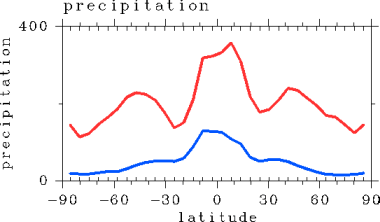3. Results |
e. Changes in the Equilibrium State (Precipitation Distribution)
The meridional contrast in the thermal structure of the atmosphere is reduced with an increase in solar constant. Here, we will briefly discuss the factors that contribute to the reduction.
Figure 1 shows the meridional distribution of precipitation for S1380 and S1570. As can be seen in the figure, the precipitation is higher for S1570 than S1380 at all latitudes. The increase in precipitation in the equatorial regions and at latitudes near 40-50° is especially notable. These results indicate that the effect of condensation heating is enhanced in these two regions by the increase in the solar constant. Thus, precipitation is greatly increased at high latitudes, which indicates that the condensation heating accompanying precipitation heats the high latitudes. This is the cause of the meridional contrast reduction in the thermal structure of the atmosphere.
The change in precipitation distribution induces a change in the evaporation and radiative cooling distribution. It also brings about a change in the heat balance between the surface and the atmosphere. For detailed descriptions on the change in heat balance associated with change in solar constant, see Meridional Distribution of Energy Flux. Furthermore, the feature of Meridional Energy Transport also changes with increase in solar constant. As solar constant increases, an increase is observed in the activities of Disturbances that are generated near the equator and moves to the mid- to high latitudes. This is accompanied by an increase in the flux of latent heat transport, and as a result, exceptionally heavy precipitation occurs in the high latitudes.

Figure 1: The meridional distribution of precipitation (W/m2) for experiments of S1380 (blue line) and S1570 (red line).
Figures referred in this section are listed as follows. These are parts of Appendix E